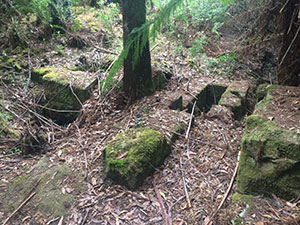ARC Project Planning
A series of meetings of the project team at Port Arthur and Hobart in the week beginning 20 March clarified the scope and outcomes of the project.
A series of meetings of the project team at Port Arthur and Hobart in the week beginning 20 March clarified the scope and outcomes of the project. The meetings included site inspections of numerous under-explored locations of convict industry near the Port Arthur Historic Site, including a stone quarry and the Cascades probation station and timber-processing site.
The team discussed the need for a consistent integration of the historical and archaeological components of the project, beginning with a well-targeted and tightly focused ‘position paper’ outlining the project methodology. It was agreed also to begin devising a geo-locational classification and coding system for the Tasman Peninsula for the purpose of matching and integrating archival and geo-locational data. A major focus of the project will be to link the archival data to landscape evolution and development.
 It was also agreed that the long-term project outcomes would include innovative visualization and digital interpretation outputs as a means of adapting and communicating the research findings for the benefit of the Port Arthur Historical Site Management Authority as a key partner and investor in the project.
It was also agreed that the long-term project outcomes would include innovative visualization and digital interpretation outputs as a means of adapting and communicating the research findings for the benefit of the Port Arthur Historical Site Management Authority as a key partner and investor in the project.
The early phases of the project hinge on the transcription and collection of historical documents and data from a number of key sources. The more ambitious dataset will commence immediately, orchestrated by the PAHSMA Resource Centre Manager, Susan Hood. Using an existing list of roughly 11,000 convicts who served at Port Arthur during its various phases between 1830-1877, information will be drawn from the monumental Conduct Registers of Tasmanian convicts, which are among the records of the Tasmanian Convict Department inscribed on the Memory of the World Register in 2007 and digitised for the Tasmanian Archives and Heritage Office. The data will absorbed into the ARC-funded Founders and Survivors database, significantly supplementing the 4% sample of Conduct Records currently housed in that database. When completed, this will allow for a comprehensive, indeed the first ever, overview of the Port Arthur convict populations, including vital demographic and occupational information and data on colonial offence and punishment histories for each individual. From this the project team can begin to trace and quantify critical aspects of the ecology of convict labour on the Tasman Peninsula.
[Top image: University of Tasmania historian, Professor Hamish Maxwell-Stewart, in Port Arthur.]
[Bottom image: Port Arthur, and the remnants of an old structure and brickwork.]
Contact:
Email:

